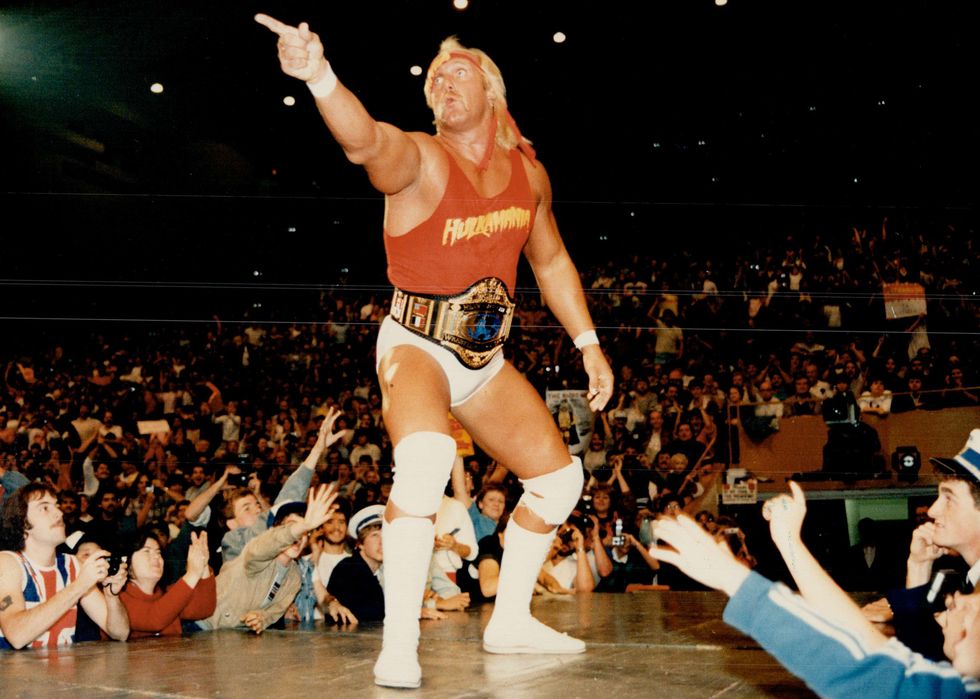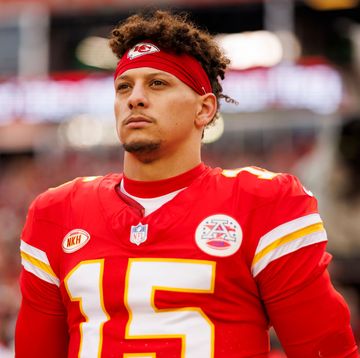As one of the most recognizable wrestlers in history, Hulk Hogan amassed such a crazed following the sensation became known as “Hulkamania.” The enthusiasm was well warranted during his 33-year career, when he won 12 world titles—six with World Championship Wrestling and six with World Wrestling Entertainment (WWE), making him at one time WWE’s highest-paid athlete.
But Hogan, who died Thursday, July 24, in Clearwater, Florida, at age 71, is remembered for much more than just wrestling. After an admission of drug abuse halted his career, he started on a rocky new path that included the autobiography Hollywood Hulk Hogan, his reality show Hogan Knows Best, and eventually a return to wrestling.
Hogan also faced family drama, with his son imprisoned for a reckless driving accident, his wife filing for divorce, and estrangement from his daughter. Scandal followed with a sex tape in which Hogan was caught making racist and homophobic remarks. He won $140 million in a defamation lawsuit (eventually settling for much less) against Gawker, which had published the footage.
Here are 10 things you may not know about the larger-than-life wrestler and his eventful career:
Hogan’s ring name started on a talk show
Born Terry Eugene Bollea in 1953, Hogan wrestled under various names—including Terry Boulder, Super Destroyer, and Sterling Golden—in his early days in the late 1970s. But when Hogan was on a talk show with Lou Ferrigno, the actor and bodybuilder who played Marvel comics character the Incredible Hulk on TV, the host recognized the 6-foot-7, 300-pound wrestler was actually bigger than Ferrigno, thus dubbing him the Hulk.
When WWE promoter Vincent McMahon Sr. asked him to take on an Irish personality in 1979, he became Hulk Hogan. His first reaction was one of skepticism. “Wow, Hulk Hogan sounds like a Hulk Hoagie or something,” he recalled. “But the name stuck. It worked, and it’s just incredible the name stood the test of time.”
Hogan’s first passion was baseball
Growing up in Tampa, Hogan had his sights set on a career as a big league pitcher. His Interbay Little League team even played in the national regional finals in 1966; though Hogan gave up the game-winning home run, so his team didn’t make it to the Little League World Series.
MLB scouts soon had their eyes on the teenager, but he injured his throwing elbow during his final year of high school. His dreams of dominating the pitcher’s mound were over. “It was the best thing that ever happened to me, because I segued into wrestling," Hogan told the MLB. “Once my arm wasn’t what it was, I started chasing the wrestling dream around, and it finally happened. But baseball was the first love.”
He started a music career
Hogan started playing guitar when he was in junior high. “I wasn’t a big sports guy,” he told Vice. “I was into music and had long hair.” He soon started playing bass guitar in bands, including one called Ruckus. They played rock ’n’ roll covers and also had about five original songs. “Our band was so tight,” Hogan said. “The whole building would move when we played.”
They were clearly on the right track toward musical success. “We were out there playing for money to get on our feet and get ready to do what we needed to do,” he said. They had the chance to tour with Mother’s Finest and Blackfoot, but the other members in the band had families and chose not to travel.
Hogan used to be scared of wrestlers
Though he was always a “huge” wrestling fan, he wasn’t exactly comfortable with the scene. “As a kid I was scared to death of them because back in the day wrestlers were very protective, and if you called wrestling fake, they would punch you in the face,” Hogan told Vice. “Back in the day there were no lawyers, no lawsuits and obviously no cell phones so no one could take pictures—so wrestlers could do whatever they wanted.”
But a funny thing happened. A handful of wrestlers started showing up at his music gigs. Word spread through the community. “All of a sudden, before I knew it, there were a bunch of wrestlers at our gigs,” he continued. So I finally got enough guts to start talking to Oliver Humperdink, who was managing ‘Superstar’ Billy Graham, and I told him I wanted to try out to be a wrestler. He was like, ‘Yeah, sure, come on down, we’ll give you a tryout.’ CRACK, broke my leg.”
It didn’t take long for Hogan to recover from the unexpected injury.
Hogan got his parents’ blessing after his first title
When he won his first title in 1984 by famously escaping the “camel clutch” of the Iron Sheik, it was a great moment in wrestling history. For Hogan, the victory was more important because his parents were in the audience.
He had tried studying finance and management at the University of South Florida and giving music a serious look before settling on the ring. “I finally quit for good to be a professional wrestler,” he said. “It just killed both my parents. It just ruined their hopes and dreams for me. So, we had a very strained relationship for quite a long time.”
But that victory in Madison Square Garden changed everything. “My dad and mom came to the dressing room, and they both said how proud they were of me,” he said. “They were very, very happy that I made that decision to be a wrestler. So that was the personal greatest moment ever in my career.”
His WrestleMania III match against Andre the Giant changed the industry
Often hailed as one of the most notable matchups in wrestling history, Hogan took on Andre the Giant in 1987 in front of 90,000 fans in the Pontiac Silverdome in Detroit. Bleacher Report called the clash the “first truly epic match in WrestleMania’s long and illustrious history” because it was the “epitome of perfect booking” and both wrestlers were “suited for a match of that magnitude.”
While Andre had a far longer tenure than Hogan, it was the newcomer who won with a bodyslam and leg drop. “When I got that 7-foot-4, almost 700 pound, big, stinky giant up over my head and slammed him down in front of 93,000 people, it sent tremors around the world,” Hogan said. “It was the greatest thing I ever did in the wrestling ring. It was a one-time deal, brother. I’m glad that giant went up and came crashing down.”
In reality, Andre was closer to 500 pounds, but that didn’t matter. Hogan’s newfound fame from the “slam heard ’round the world” was credited for popularizing the sport.
His Rocky III cameo impressed Sylvester Stallone
Hogan made his film debut as Thunderlips in the 1982 movie Rocky III—and the first-time screen star may not have recognized his own strength, as star and director Sylvester Stallone recounted in a 2017 Instagram post. “I remember a violent move where he threw me into the corner, charged across the ring like an enraged bull and leaped so amazingly high above me that his shinbone actually came down [like a] giant tree on my collarbone,” Stallone wrote. “I have never felt such a mind numbing pain from a massive hit before or since that day!”
He wasn’t the only one to experience Hogan’s power first hand. “When he jumped into the audience to fight with the stuntmen, three of them had to be treated at the hospital,” Stallone revealed, adding, “Great guy, great friend, his presence made the film very, very special.”
Hogan continued to star in other movies such as Suburban Commando (1991), Mr. Nanny (1993), and Santa with Muscles (1996).
Hogan Knows Best was an instant hit
The reality show Hogan Knows Best following the wrestler’s family—Hulk, his then-wife Linda, daughter Brooke, and son Nick—broke records when it debuted in the summer of 2005, becoming VH1’s highest-rated series premiere, as well as its highest-rated regular telecast ever at the time. It was part of the cable network’s Sunday night “Celebreality” programming block.
The show ran for four seasons through October 2007. What they didn’t predict was that the show would end up following Hogan and Linda’s marital troubles, with the two filing for divorce in 2007. That same year, Nick was in a car incident that critically injured his friend John Graziano and was sentenced to eight months in prison.
Hogan and Brooke later became estranged, with his daughter skipping his wedding to new wife Sky Daily in 2023. Brooke gave birth to twins, Oliver and Molly, in January 2025, making Hogan a first-time grandfather.
He tried to join the Rolling Stones and Metallica
Well into his wrestling career, Hogan started contemplating other career options. “I always still loved music,” he told Vice. When he was in the United Kingdom for an awards show, he overheard Mick Jagger’s then-wife Jerry Hall say the Rolling Stones needed a bass player. “I was like, ‘Look, I used to play bass. I know all the Rolling Stones songs. Tell Mick if you guys need a bass player for the Rolling Stones, I swear to god I could show up,’ he recalled. “I could rehearse one day and play everything they play.” But the call never came.
Later, Hogan heard Metallica had an opening for a bass player. “I was writing letters, made a tape of myself playing and sent it to their management company,” he said. “Kept making calls trying to get through. I tried for two weeks and never heard a word back from them either.”
Randy Savage rapped a diss track about Hogan
In “Macho Man” Randy Savage’s 2003 song “Be a Man,” he added plenty more fuel to their real-life feud. “The story goes that Hogan ended up stealing [Savage’s ex-wife Miss Elizabeth] away, and she died of a drug overdose, and he blamed it on Hulk,” Bill Edwards, founder of Big3 record label, said. “He always wanted to go back in the ring and duke it out for real, and Hulk would never do it. Hence, ‘Be a Man.’ The whole message of the song was to call him out.”
That’s pretty apparent with lyrics such as: “Used to be hard Hulk now ya done turned soft.”
After an eight-year rift, the wrestlers finally reconciled after running into each other at a doctor’s office in Tampa. “I just thank God that we got back together before he passed away,” Hogan said of Savage, who died in May 2011.
Tyler Piccotti joined the Biography.com staff as an Associate News Editor and is now the News and Culture Editor. He previously worked as a reporter and copy editor for a daily newspaper recognized by the Associated Press Sports Editors. In his current role, he shares the true stories behind your favorite movies and TV shows and profiles rising musicians, actors, and athletes. When he's not working, you can find him at the nearest amusement park or movie theater and cheering on his favorite teams.
















